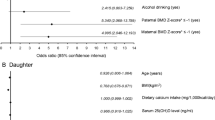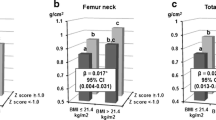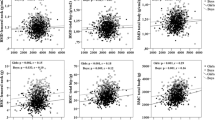Abstract
We examined familial bone mineral density (BMD) interactions between parents and children and lifestyle factors affecting BMD in the Korean general population of children under 20 and parents under 50 years of age. This cross-sectional study included 2,453 participants (667 daughters, 705 sons, 719 mothers, and 362 fathers) in the 2009–2010 Korean National Health and Nutrition Examination Survey. We calculated prevalence ratios and 95 % confidence intervals for BMD values of whole femur, femur neck, lumbar spine, and whole body excluding the head being in the low tertile in adolescents according to parental BMD tertile after adjusting for physical, lifestyle, and dietary factors. For daughters and sons, there were significant differences in BMD at the four bone sites according to age group, body fat percentage, regular walking and exercise, and milk consumption compared to the reference value for each classification category. Surprisingly, there were no differences in BMD according to serum 25-OH-D levels. Birth order affected BMD of only whole body except head, but its impact was less than that of lifestyle factors. The mean differences in BMD between daughters and sons in the first and third parental BMD tertiles were statistically significant. Notably, the prevalence ratio of whole body without head BMD being in the low tertile increased eight and ten-folds in adolescent daughters and sons, respectively, when parents were in the low BMD tertile. In specific bone regions, parental BMD had a greater effect on total femur in daughters but in the lumbar spine in sons. In conclusion, parental BMD positively influences BMD in daughters and sons after adjustment for environmental parameters. This suggests that the children from parents with low BMD need to make an extra effort to increase BMD through dietary and lifestyle changes.

Similar content being viewed by others

References
Johnell O, Kanis JA (2006) An estimate of the worldwide prevalence and disability associated with osteoporotic fractures. Osteoporos Int 17:1726–1733
Emaus N, Berntsen GKR, Joakimsen RM, Fonnebo V (2005) Longitudinal changes in forearm bone mineral density in women and men aged 25–44 years. Am J Epidemiol 162:633–643
Specker BL, Wey HE, Smith EP (2010) Rates of bone loss in young adult males. Int J Clin Rheumtol 5:215–228
Hansen MA, Overgaard K, Riis BJ, Christiansen C (1991) Role of peak bone mass and bone loss in postmenopausal osteoporosis, 12 year study. BMJ 303:961–964
Harris M, Nguyen TV, Howard GM, Kelly PJ, Eisman JA (1998) Genetic and environmental correlations between bone formation and bone mineral density, a twin study. Bone 22:141–145
Seeman E, Hopper JL, Young NR, Formica C, Goss P, Tsalamandris C (1996) Do genetic factors explain associations between muscle strength, lean mass, and bone density? A twin study. Am J Physiol 270:E320–E327
Ohta H, Kuroda T, Onoe Y, Nakano C, Yoshikata R, Ishitani K, Hashimoto K, Kume M (2010) Familial correlation of bone mineral density, birth data and lifestyle factors among adolescent daughters, mothers and grandmothers. J Bone Miner Metab 28:690–695
Runyan SM, Stadler DD, Bainbridge CN, Miller SC, Moyer-Mileur LJ (2003) Familial resemblance of bone mineralization, calcium intake, and physical activity in early-adolescent daughters, their mothers, and maternal grandmothers. J Am Diet Assoc 103:1320–1325
Lutz J, Tesar R (1990) Mother–daughter pairs, spinal and femoral bone densities and dietary intakes. Am J Clin Nutr 52:827–872
McKay HA, Bailey DA, Wilkinson AA, Houston CS (1994) Familial comparison of bone mineral density at the proximal femur and lumbar spine. Bone Miner 24:95–107
Kuroda T, Onoe Y, Miyabara Y, Yoshikata R, Orito S, Ishitani K, Okano H, Ohta H (2009) Influence of maternal genetic and lifestyle factors on bone mineral density in adolescent daughters, a cohort study in 387 Japanese daughter–mother pairs. J Bone Miner Metab 27:379–385
Zhu K, Du X, Greenfield H, Zhang Q, Ma G, Hu X, Fraser DR (2004) Bone mass in Chinese premenarcheal girls, the roles of body composition, calcium intake and physical activity. Br J Nutr 92:985–993
Mølgaard C, Thomsen BL, Michaelsen KF (2001) The influence of calcium intake and physical activity on bone mineral content and bone size in healthy children and adolescents. Osteoporos Int 12:887–894
Eastell R, Lambert H (2002) Diet and healthy bones. Calcif Tissue Int 70:400–404
Shin CS, Choi HJ, Kim MJ, Kim JT, Yu SH, Koo BK, Cho HY, Cho SW, Kim SW, Park YJ, Jang HC, Kim SY, Cho NH (2010) Prevalence and risk factors of osteoporosis in Korea, a community-based cohort study with lumbar spine and hip bone mineral density. Bone 47:378–387
Park S, Lee BK (2012) Inverse relationship between fat intake and blood lead levels in the Korean adult population in the KNHANES 2007–2009. Sci Total Environ 430:161–166
Kim KM, Lim JS, Kim KJ, Choi HS, Rhee Y, Oh HJ, Choi H, Choi WH, Kim JG, Lim SK (2013) Dissimilarity of femur aging in men and women from a Nationwide Survey in Korea (KNHANES IV). J Bone Miner Metab 31:144–152
Seo JY, Cho YG, Kang JH, Hur YI, Park HA, Kim KW, Kwon SK (2013) New diagnostic criteria for obesity and overweight in Korean children and adolescents using 2007 Korean National Growth Charts. Obes Res Clin Pract 7:e182–e189
Khor GL (2008) Food-based approaches to combat the double burden among the poor: challenges in the Asian context. Asia Pac J Clin Nutr 17:111–115
Bae JC, Suh S, Park SE, Rhee EJ, Park CY, Oh KW, Park SW, Kim SW, Hur KY, Kim JH, Lee MS, Lee MK, Kim KW, Lee WY (2012) Regular exercise is associated with a reduction in the risk of NAFLD and decreased liver enzymes in individuals with NAFLD independent of obesity in Korean adults. PLoS ONE 7:e46819
Jeon CY, Lokken RP, Hu FB, van Dam RM (2007) Physical activity of moderate intensity and risk of type 2 diabetes: a systematic review. Diabetes Care 30:744–752
Park S, Kim MY, Baik SH, Woo JT, Kwon YJ, Daily JW, Park YM, Yang JH, Kim SH (2013) Gestational diabetes is associated with high energy and saturated fat intakes and with low plasma visfatin and adiponectin levels independent of prepregnancy BMI. Eur J Clin Nutr 67:196–201
Pfeffermann D (1996) The use of sampling weights for survey data analysis. Stat Methods Med Res 5:239–261
Katzmarzyk PT, Barreira TV, Harrington DM, Staiano AE, Heymsfield SB, Gimble JM (2012) Relationship between abdominal fat and bone mineral density in white and African American adults. Bone 50:576–579
Hull HR, Thornton J, Wang J, Pierson RN Jr, Kaleem Z, Pi-Sunyer X, Heymsfield S, Albu J, Fernandez JR, Vanitallie TB, Gallagher D (2011) Fat-free mass index, changes and race/ethnic differences in adulthood. Int J Obes (Lond) 35:121–127
Janicka A, Wren TA, Sanchez MM, Dorey F, Kim PS, Mittelman SD, Gilsanz V (2007) Fat mass is not beneficial to bone in adolescents and young adults. J Clin Endocrinol Metab 92:143–147
Boot AM, Krenning EP, de Muinck Keizer-Schrama SM (2011) The relation between 25-hydroxy vitamin D with peak bone mineral density and body composition in healthy young adults. J Pediatr Endocrinol Metab 24:355–360
Baptista F, Barrigas C, Vieira F, Santa-Clara H, Homens PM, Fragoso I, Teixeira PJ, Sardinha LB (2012) The role of lean body mass and physical activity in bone health in children. J Bone Miner Metab 30:100–108
Amarendra Reddy G, Kulkarni B, Shatrugna V, Thilak Ravindra Reddy P, Nagalla B, Ajeya Kumar P, Usha Rani K (2009) Bone mass of overweight affluent Indian youth and its sex-specific association with body composition. Arch Osteoporos 4:31–39
Lambert HL, Eastell R, Karnik K, Russell JM, Barker ME (2008) Calcium supplementation and bone mineral accretion in adolescent girls, an 18-mo randomized controlled trial with 2-y follow-up. Am J Clin Nutr 87:455–462
Chevalley T, Rizzoli R, Hans D, Ferrari S, Bonjour JP (2005) Interaction between calcium intake and menarcheal age on bone mass gain, an eight-year follow-up study from prepuberty to post menarche. J Clin Endocrinol Metab 90:44–51
Han E, Kim TH, Powell LM (2013) Beverage consumption and individual-level associations in South Korea. BMC Public Health 13:195
Heaney RP (2000) Calcium, dairy products and osteoporosis. J Am Coll Nutr 19:83S–99S
Andıran N, Çelik N, Akça H, Doğan G (2012) Vitamin D deficiency in children and adolescents. J Clin Res Pediatr Endocrinol 4:25–29
Oren Y, Shapira Y, Agmon-Levin N, Kivity S, Zafrir Y, Altman A, Lerner A, Shoenfeld Y (2010) Vitamin D insufficiency in a sunny environment, a demographic and seasonal analysis. Isr Med Assoc J 12:751–756
Mark S, Gray-Donald K, Delvin EE, O’Loughlin J, Paradis G, Levy E, Lambert M (2008) Low vitamin D status in a representative sample of youth from Québec, Canada. Clin Chem 54:1283–1289
Novotny R, Daida YG, Grove JS (2004) Adolescent dairy consumption and physical activity associated with bone mass. Prev Med 39:355–360
Gracia-Marco L, Moreno LA, Ortega FB, León F, Sioen I, Kafatos A, Martinez-Gomez D, Widhalm K, Castillo MJ, Vicente-Rodríguez G, HELENA Study Group (2011) Levels of physical activity that predict optimal bone mass in adolescents, the HELENA study. Am J Prev Med 40:599–607
Deere K, Sayers A, Rittweger J, Tobias J (2012) Habitual levels of high, but not moderate or low, impact activity are positively related to hip BMD and geometry, Results from a population-based study of adolescents. J Bone Miner Res 27:1887–1895
Heaney RP, Abrams S, Dawson-Hughes B, Looker A, Marcus R, Matkovic V, Weaver C (2000) Peak bone mass. Osteoporos Int 11:985–1009
Ferrari S, Rizzoli R, Slosman D, Bonjour JP (1998) Familial resemblance for bone mineral mass is expressed before puberty. J Clin Endocrinol Metab 83:358–361
Jouanny P, Guillemin F, Kuntz C, Jeandel C, Pourel J (1995) Environmental and genetic factors affecting bone mass. Arthr Rheum 38:61–67
Margarey AM, Boulton TJC, Chatterton BE, Schultz C, Nordin BEC (1999) Familial and environmental influences on bone growth from 11–17 years. Acta Paediatr 88:1204–1210
Bounds W, Skinner J, Carruth BR, Ziegler P (2005) The relationship of dietary and lifestyle factors to bone mineral indexes in children. J Am Diet Assoc 105:735–741
Lim JS, Hwang JS, Lee JA, Kim DH, Park KD, Cheon GJ, Shin CH, Yang SW (2010) Bone mineral density according to age, bone age, and pubertal stages in Korean children and adolescents. J Clin Densitom 13:68–76
Cvijetic S, Colic Baric I, Satalic Z (2010) Influence of heredity and environment on peak bone density, a parent–offspring study. J Clin Densitom 13:301–306
Nordström P, Lorentzon R (1999) Influence of heredity and environment on bone density in adolescent boys, a parent–offspring study. Osteoporos Int 10:271–277
Conflict of interest
The authors declare no conflict of interest.
Author information
Authors and Affiliations
Corresponding author
About this article
Cite this article
Park, S., Park, CY., Ham, JO. et al. Familial interactions and physical, lifestyle, and dietary factors to affect bone mineral density of children in the KNHANES 2009–2010. J Bone Miner Metab 32, 455–467 (2014). https://doi.org/10.1007/s00774-013-0515-0
Received:
Accepted:
Published:
Issue Date:
DOI: https://doi.org/10.1007/s00774-013-0515-0



